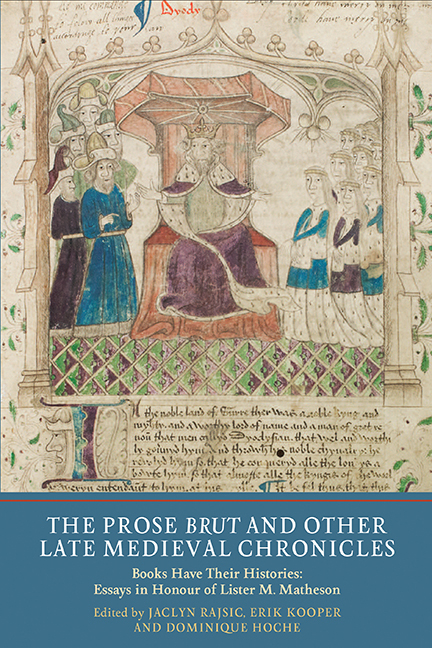 The Prose Brut and Other Late Medieval Chronicles
The Prose Brut and Other Late Medieval Chronicles Book contents
- Frontmatter
- Dedication
- Contents
- List of Plates
- List of Contributors
- Acknowledgements
- Curriculum Vitae of Lister M. Matheson
- Introduction
- A Memoir: The Whole Haggis: Lessons From the Work of Lister M. Matheson
- Part I Uses of History
- Part II The Prose Brut
- Part III Receptions and Afterlives of Late Medieval Chronicles
- 9 Trevet's Les Cronicles: Manuscripts, Owners and Readers
- 10 Matthew Parker and the Middle English Prose Brut
- 11 Thomas Hearne and English Chronicles
- 12 The Manuscript of Castleford's Chronicle: Its History and its Scribes
- 13 Bruts for Sale
- Index of Manuscripts Cited
- General Index
- Tabula in Memoriam
13 - Bruts for Sale
from Part III - Receptions and Afterlives of Late Medieval Chronicles
Published online by Cambridge University Press: 05 July 2016
- Frontmatter
- Dedication
- Contents
- List of Plates
- List of Contributors
- Acknowledgements
- Curriculum Vitae of Lister M. Matheson
- Introduction
- A Memoir: The Whole Haggis: Lessons From the Work of Lister M. Matheson
- Part I Uses of History
- Part II The Prose Brut
- Part III Receptions and Afterlives of Late Medieval Chronicles
- 9 Trevet's Les Cronicles: Manuscripts, Owners and Readers
- 10 Matthew Parker and the Middle English Prose Brut
- 11 Thomas Hearne and English Chronicles
- 12 The Manuscript of Castleford's Chronicle: Its History and its Scribes
- 13 Bruts for Sale
- Index of Manuscripts Cited
- General Index
- Tabula in Memoriam
Summary
BY 1918 Henry Huntington had already laid the foundations of his great collections that were to form the Huntington Library and Art Gallery in San Marino, California. Some of the most important literary treasures, the Ellesmere manuscripts, including the Ellesmere Chaucer and the Chester Plays, had already arrived. But if his collection of Middle English manuscripts included such remarkable high spots, it still lacked range and depth. In November of that year, George D. Smith, the New York book dealer and Huntington's first agent in the creation of his library, drew his attention to a rather unpretentious manuscript that was about to be included in the Herschel Jones sale: ‘The Brut's [sic] Chronicle is very important for your library,’ he insisted. It was not a work that figured already in Huntington's collection and he took Smith's advice: Jones's manuscript quickly became manuscript Huntington HM 131 when it was sold in December 1918. And Huntington himself seems to have been quick to appreciate the implications of Smith's comment on the significance of the work, as he added three more Bruts to his library before his death in 1927.
One may wonder how typical in the twentieth century was Smith's appreciation of the work's value to a research library and how any sense of the Brut's significance was reflected in commercial activity involving the Brut, that is, in the various sales of manuscript copies of it in this period. The larger history of the buying and selling of Middle English manuscripts is a neglected subject. However, evidence of the perceived worth of such manuscripts in the market place potentially offers some insight into other aspects of their ‘value’ that extends beyond the simply monetary, to reflect the evolving history of their reception. Such issues have never been surveyed hitherto in their commercial terms.
Yet, the number of manuscripts disposed of commercially in the twentieth century and the prices they achieved provide an unusually large body of evidence for assessing this aspect of the Brut's reception. It is the most widely circulated Middle English historical text. Lister Matheson has given a detailed record of surviving copies together with several others that may exist or have existed but cannot now be found, and this has been supplemented in a posthumously published article. Clearly about 180 or so manuscripts survive.
- Type
- Chapter
- Information
- The Prose Brut and Other Late Medieval ChroniclesBooks have their Histories. Essays in Honour of Lister M. Matheson, pp. 218 - 232Publisher: Boydell & BrewerPrint publication year: 2016
